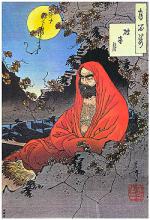Disable ads!
Bodhidharma
Part of a series on Zen Buddhism Main articles Zen Chinese Chán Vietnamese Thiền Korean Seon Japanese Zen Zen in the USA Persons Chán in China Bodhidharma Huineng (Enō) Mazu Daoyi (Baso) Shitou Xiqian (Kisen) Dongshan Liangjie (Tozan) Xuefeng Yicun (Seppo) Linji Yixuan (Rinzai) Dahui Zonggao (Tahui) Zen in Japan Dogen Hakuin Seon in Korea Taego Bou Jinul Seongcheol Zen in the USA D.T. Suzuki Hakuun Yasutani Taizan Maezumi Shunryu Suzuki Seung Sahn Category: Zen Buddhists Doctrines Zen and Sutras Doctrinal background of Zen Buddha-nature Yogacara Sunyata Bodhisattva Traditions Dharma transmission Zen lineage charts Zen ranks and hierarchy Zen organisation and institutions Zen Narratives Awakening Kensho Satori Sudden Enlightenment Silent illumination Teachings Ten Ox-Herding Pictures Five ranks of Tozan Three mysterious Gates Four Ways of Knowing Practice Zazen / Shikantaza Kōan practice Schools East Mountain Teaching Hongzhou school Five Houses of Chán Rinzai school Sōtō school Sanbo Kyodan White Plum Asanga Related schools Huayan Tiantai Pure Land Buddhism v t e Part of a series on Chinese Buddhism 汉传佛教 / 漢傳佛教 Hànchuán Fójiào History Gandhara Kushan Empire Dharmaguptaka Silk Road transmission Major figures Kumārajīva Xuanzang Huiyuan Zhiyi Bodhidharma Huineng Taixu Hsu Yun Hsuan Hua Nan Huai-Chin Traditions Chán Tiantai Huayan Pure Land Weishi Sanlun Tangmi Texts Chinese Buddhist canon Taishō Tripiṭaka Architecture Buddhist architecture in China Bodhimaṇḍas Wutai Emei Jiuhua Putuo Culture Buddhist Association of China Cuisine Martial arts Diyu v t e Bodhidharma was a Buddhist monk who lived during the 5th or 6th century CE. He is traditionally credited as the transmitter of Ch'an to China, and regarded as its first Chinese patriarch. According to Chinese legend, he also began the physical training of the Shaolin monks that led to the creation of Shaolin Kung Fu. Little contemporary biographical information on Bodhidharma is extant, and subsequent accounts became layered with legend. [note 1] The principal Chinese sources vary on their account of Bodhidharma's origins, giving either an origin from India or from the Greco-Buddhist traditions of Iranian language speaking Central Asian kingdoms. [note 2] Throughout Buddhist art, Bodhidharma is depicted as a rather ill-tempered, profusely bearded and wide-eyed barbarian. He is referred as "The Blue-Eyed Barbarian" (碧眼胡:Bìyǎn hú) in Chinese Chan texts. Aside from the Chinese accounts, several popular traditions also exist regarding Bodhidharma's origins.[note 4] The accounts also differ on the date of his arrival, with one early account claiming that he arrived during the Liú Sòng Dynasty (420–479) and later accounts dating his arrival to the Liáng Dynasty (502–557). Bodhidharma was primarily active in the lands of the Northern Wèi Dynasty (386–534). Modern scholarship dates him to about the early 5th century. Several stories about Bodhidharma have become popular legends, which are still being used in the Ch'an and Zen tradition. Bodhidharma's teachings and practice centered on meditation and the Lankavatara Sutra. The Anthology of the Patriarchal Hall (952) identifies Bodhidharma as the 28th Patriarch of Buddhism in an uninterrupted line that extends all the way back to the Buddha himself.
 Read more on wikipedia.org Read more on wikipedia.org
 All quotes by Bodhidharma All quotes by Bodhidharma
 Edit Edit
|

|
|
|
|
|
Background photo by Giuliana
|